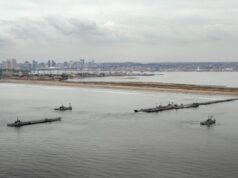United States Defense Secretary Ashton Carter announced on Tuesday that Washington will position tanks, artillery, and other military equipment throughout Eastern and Central Europe, and work with NATO allies to bolster cybersecurity infrastructure of member nations. These moves are designed to bolster the confidence of countries formerly controlled by the Soviet Union following increased Russian bellicosity, including the announcement last week that Moscow will add 40 intercontinental ballistic missiles to its nuclear arsenal within the year.
The U.S. released a fact sheet stating that pre-positioning efforts include approximately 250 tanks, Bradley infantry fighting vehicles, and self-propelled howitzers. Carter plans to deploy most of the arms and heavy equipment in Estonia, Lithuania, Latvia, Bulgaria, Romania, and Poland, with some additional weaponry in Germany.

Secretary of Defense Ash Carter waves to aircrew members on June 21st as he prepares to depart for Europe. (Photo: Master Sgt. Adrian Cadiz) |
Russian President Vladimir Putin retaliated with a strongly worded statement claiming that the deployment would be the most aggressive since the Cold War. The Russian Foreign Ministry released its own warning to U.S. and its European allies saying that boosting NATO forces near Russian borders might have “dangerous consequences.”
Many of the states receiving NATO reinforcements have sizeable ethnic Russian minorities. Moscow’s invasion and annexation of Crimea in Ukraine, under the auspices of protecting Russian speakers abroad, left the Baltic states nervous about NATO’s resolve against Putin’s aggression. Additionally, Europeans are concerned with a dramatic increase in the number of Russian overflights near allied airspace late last year. Allied warplanes regularly intercept Russian fighters and bombers over the Baltic Sea, showing Putin’s unwillingness to de-escalate the situation.
Russia’s democratic neighbors see the increase in deployment of U.S. military equipment as reassurance of Western support. Sven Misker, the Estonian Defense Minister believes that “Russia views the Baltic region as one of NATO’s most vulnerable areas, a place where NATO’s resolve and commitment could be tested.” Although it has caveats, Article 5 of the NATO treaty generally stipulates that an attack on one member state is considered an attack on all member states.
Secretary Carter claims that the United States is “absolutely committed” to protecting its NATO allies and points to the addition of more heavy equipment as evidence of this. But, as Russia continues to take a more assertive role in the region, Central European and Baltic leaders are concerned that the attention of U.S. leaders seems focused on other conflicts.





